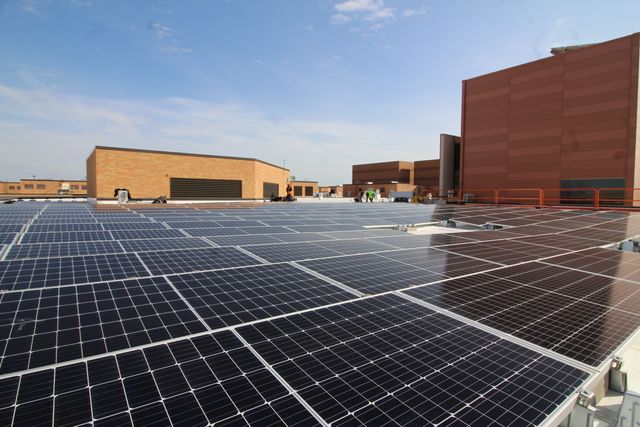Article at a Glance
- Higher Efficiency: New solar panels now convert up to 25% of sunlight to electricity, doubling older efficiencies.
- Cost-Effective Production: Advanced materials and methods make solar technology more affordable.
- AI Optimization: AI improves panel positioning, energy prediction, and installation efficiency.
- Decentralized Power: Localized systems enable energy independence for homes and communities.
- Better Storage: Enhanced battery options, including V2G tech, ensure solar power reliability day or night.
As the world looks for solutions to climate change, reducing our reliance on fossil fuels and shifting focus to renewable energy sources is a priority. This shift is spurring unprecedented growth in solar energy technology and finding new ways to harness the sun’s power. As the industry continues to advance rapidly, it spurs new solar technology trends that are making it easier and more affordable than ever for consumers to access affordable, reliable, and clean energy.
Here, we’ll explore some of these trends and what they mean for the future of solar technology moving forward.
Solar Technology Trends That Are Changing the Industry
New solar energy technology supports the continual evolution of the energy sector and our ability to capture power from the sun. In light of that rapid growth, watch for these latest trends.
More Affordable Solar Energy Technology
New solar technology is making it more affordable than ever for homeowners and commercial enterprises to invest in renewable energy. Research into technologies like perovskite solar cells and more efficient energy storage is making solar power more accessible and stable.
Solar panel manufacturing costs are also lower than ever before, thanks to advanced materials and better manufacturing techniques. Continued investment in research and development will further reduce the price and make solar technology more accessible.
AI-Driven Advancements in Solar Technology
AI is on everyone’s minds, and solar technology is no exception. The potential applications of AI to renewable energy are one of the most prevalent solar technology trends. Using AI strategically can help make solar energy projects more efficient and cost-effective by streamlining manufacturing and installation timelines.
For example, solar companies are already using AI-driven technologies and algorithms to maximize efficiency by determining the best positioning for solar panels and more accurately predicting their energy output. This ensures the maximum return on the investment and the best system management.
Solar Panel Technology Advances to Decentralize Power
Another entry on the list of solar technology trends to watch is the shift toward giving users more control over how they produce and use solar power. A decentralized solar power system allows homeowners, commercial enterprises, communities, and peer-to-peer energy-sharing platforms to generate, store, and share electricity locally. This supports greater energy independence and resilience while also making new solar technology more affordable and accessible.
Incentives To Invest In New Solar Technology And Installation
Another reason new solar technology is becoming more widespread and accessible is the continued availability of incentives to encourage the adoption of alternative, renewable energy sources. When local, state, and federal agencies offer policy support and incentives, adopting solar becomes more affordable and attractive.
Governments worldwide are creating favorable conditions for industry development and driving investments in the industry. Homeowners, for example, can take advantage of attractive tax credits and rebates for adding solar technology, which significantly reduces the overall cost of their investment. On a larger scale, feed-in tariffs, which guarantee an above-market price for renewable energy producers, and favorable regulations will continue to support growth within the solar power sector.
Additional read: Unlock the Facts: Are Your Illinois Solar Incentives Taxable
New Solar Energy Technology to Maximize Storage
It’s not enough to simply collect solar power; producers need to store the energy so it’s available when users need it. Improved battery technology and storage solutions will likely dominate solar panel technology advancements this year.
One technology that’s gaining traction is vehicle-to-grid (V2G) solar energy storage. As more drivers switch to electric vehicles, stores of unused electricity expand. With V2G, EV owners can use the power stored in their vehicle batteries as a source of auxiliary power for their homes during a power outage. Some EVs already have bidirectional charging capabilities, meaning you can charge the vehicle from your home outlets or power your home from the vehicle, and other manufacturers plan to add the technology to new models within the next few years.
Solar panel manufacturers are also looking for ways to increase solar battery storage, ensuring that users can access renewable energy during power outages, at night, or on cloudy days. The fact that, in many cases, homes can only run on solar energy on sunny days has many homeowners reluctant to invest in the technology. Improving storage can increase adoption.
Be on the Forefront of Solar Energy Trends
Looking at these solar technology trends, it’s easy to see that solar energy will become even more cost-effective and reliable in the future. Get on the cutting edge of low-carbon, renewable energy today by getting in touch with RxSun. Call us at 800-607-9786 or get a free quote for a solar energy consultation.
 800-607-9786
800-607-9786

 1-800-60-RXSUN
1-800-60-RXSUN